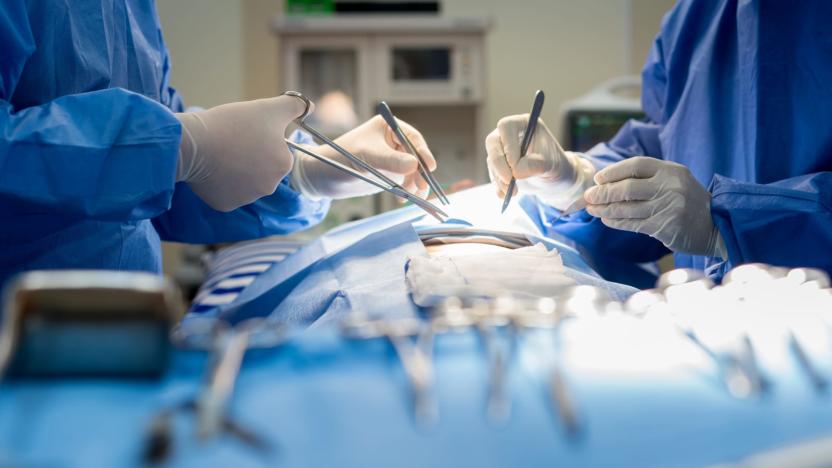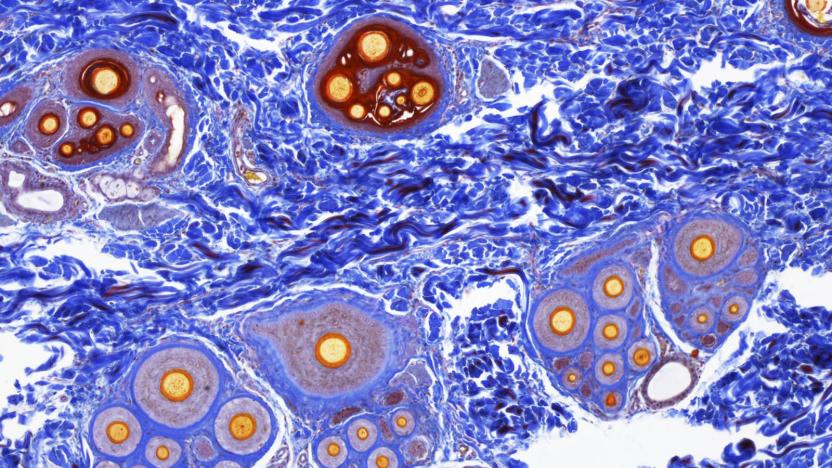cells
Latest

Lab-grown heart muscles transplanted into a human for the first time
Researchers in Japan have successfully carried out the world's first transplant of lab-grown heart muscle cells, in a move which could significantly reduce the need for heart transplants. To grow the heart muscle cells, the scientists from Osaka University first took adult stem cells and reprogrammed back into their embryonic-like state. From this point, the researchers were able to coax the cells into becoming whatever form they wanted -- in this case, heart muscle cells.

Researchers can track cell development through 'genetic barcodes'
A newborn is composed of roughly 26 billion cells when he or she enters the world naked, screaming and rather gooey. Figuring out how those multitudes of cells came to be from a single zygote remains among the greatest challenges in developmental biology. But researchers from the Wyss Institute at Harvard University may have finally cracked the code -- through the novel use of CRISPR technology to generate a genetic barcode.

AI offers a new way to look inside living human cells
Over the course of their careers, biologists develop a huge mental library of cell structures and their corresponding data. Investigating specific areas of a living cell involves a piecemeal approach, identifying how some parts work with others and spending time on cell labelling. But now, the Allen Institute for Cell Science has launched the first predictive 3D model of a live human cell -- the Allen Integrated Cell -- and it could be "a total game changer", according to researchers.

Advanced microscope shows cells at work in incredible 3D detail
For the first time, scientists have peered into living cells and created videos showing how they function with unprecedented 3D detail. Using a special microscope and new lighting techniques, a team from Harvard and the Howard Hughes Medical Institute captured zebrafish immune cell interactions with unheard-of 3D detail and resolution. The tech has already yielded new insights on cell function and could transform our understanding of how organisms function at the smallest scales.

Scientists get closer to replicating human sperm
Scientists have taken an important step forward in recreating the way the human body makes sperm, which could one day mean creating artificial sperm and eggs for infertility treatment. The researchers, from the University of Cambridge's Gurdon Institute, are thought to be the first team to have reached the "halfway point" -- a significant milestone -- on the path between stem cells and immature sperm.

Scientists find a much faster way to classify our cells
Researchers have created a new technique for identifying cell types much quicker than ever before, a finding that could improve disease diagnoses and treatments. While there are many types of cells in our bodies (red blood cells, spindle neurons, etc.), scientists don't know the exact number, because current microscope techniques are slow and laborious. By tagging cells with molecular markers, however, the team was able to read their unique RNA combinations like a bar code at exponentially higher speeds.

Stem cell therapy makes sterile mice fertile again
Researchers at Shanghai's Jiao Tong University have conducted an experiment involving stem cells and sterile mice. Germline stem cells -- the building blocks of an egg -- were taken from a young mouse and implanted into the ovary of a mouse that had been sterilized. Five to eight weeks later, and this implanted mouse was mated with a healthy to see if pregnancy would occur. The experiment, which tested eight such mice, found that six of the group managed to fall pregnant and deliver healthy offspring.

Scientists find a way to make cells respond to stimuli
Through the use of synthetic biology researchers have been able to program cells to perform unique functions, like produce drugs in response to disease markers. In order to create more complex cellular circuits, several MIT engineers have now found a way to program cells to respond to a series of events.

Artificial cell membranes could lead to more effective drugs
Medical science often targets drugs at the proteins in cell membranes. But how do you study everything about their behavior when you can't control them? That's what UC San Diego researchers aim to fix. They've developed artificial cell membranes that grow and model themselves just like those in mammal cells, making them ideal for testing how drugs will behave. The trick is to use reversible chemical reactions that remodel phospholipids (key molecules in the cell membrane) and make the cell 'recycle' them, rather than generate them from scratch. That, in turn, saves the cell a lot of effort as its membrane grows.

Researchers 3D print 'Lego bricks' of functional stem cells
A team of scientists from Beijing's Tsinghua University have reportedly devised a means of producing uniform embryonic stem cells with a 3D printer. These cells stack like organic Lego bricks and could form the structural basis for future lab-grown organs. "It was really exciting to see that we could grow embryoid body in such a controlled manner," lead author Wei Sun said in a statement. "The grown embryoid body is uniform and homogenous, and serves as a much better starting point for further tissue growth." The study published yesterday in the journal Biofabrication.

Researchers inject oil into cells and create little lasers
The Massachusetts General Hospital research team that lit up human cells with the help of jellyfish genes a few years ago are back with a more advanced version of the technology. This new version forgoes the complicated external mirror setup in favor of injectable oil droplets impregnated with fluorescent dye. This is the same basic idea as what a team from St Andrews University recently created, except that the plastic bead that served as the their laser's resonating chamber is now an oil droplet. While the technology isn't ready for therapeutic applications just yet, it does hold a great deal of promise. The problem with conventional cellular markers and dye is that they have a broad emission spectrum which can make it difficult to spot the marked cells amidst the rest of the tissue. But with these miniature lasers, doctors will be able to mark and track individual cells no matter where they are in the body. The team recently published their findings in Nature Photonics.

Scientists implant teeny, tiny lasers into human cells
A few years back, a pair of researchers at Massachusetts General Hospital made human cells glow by impregnating them with a molecule that's normally found in jellyfish called green fluorescent protein (GFP) and packing them into a resonant cavity that amplified the amount of light each cell produced. Now, according to a new study recently published in the journal Nano Letters, a team of scientists from the University of St Andrews have developed a means of making individual glowing cells also act as their own resonant cavities.

Some e-cigarette flavors may have toxic effects on lung cells
E-cigarettes may be a popular alternative to the traditional smoke sticks, despite contrasting opinions on how safe they are. Adding to the list of harmful effects, the American Thoracic Society published research at its annual conference that certain flavors used in vaping liquid may alter cells in lung tissue. During the study, researchers exposed human airway epithelial cells to doses of 13 e-cig flavors for periods of 30 minutes and 24 hours. 5 of the 13 displayed "adverse effects to cells in a dose-dependent manner." Of those five, three flavors -- Hot Cinnamon Candies, Banana Pudding (Southern Style), and Menthol Tobacco -- were toxic to lung cells at higher doses in the 30-minute test. What's more, when cells were exposed for 24 hours, the same trio of flavors stunted cell growth as the dosage increased. Also of note: the flavorings' negative effects didn't occur with nicotine or the e-liquid vehicle on its own (propylene glycol and vegetable glycerin).

Your own cells could one day 'spy' on you to track disease
Scientists from MIT have figured out how to hack living cells to store biological events around them. They modified E. Coli cells to generate so-called retrons -- a type of mutated single-strand DNA -- in response to stimuli like light or chemicals. Those lo-fi "memories" can then be read back to glean useful information using high-throughput DNA sequencing and other techniques. However, it works even better by scaling it up to billions of copies. Once the hacked cells reproduce, new ones start recording the events too, meaning scientists can track changes in an environment over time. The mutations can even be written and erased, meaning they could one day track the progress of a disease from directly inside your body, like a personal, benevolent NSA. [Image credit: Shutterstock/vitstudio]

Scientists create fully-functional brain neurons from mouse skin cells
It's a good excuse to shoehorn Pinky and the Brain on to the site, but scientists have managed to graft neurons reprogrammed from skin cells into the brains of mice. It isn't the first time that's been done, but it is the first time the researchers have had any luck with the neurons surviving into long-term stability. Better still, six months after implantation, the neurons had become fully-functional inside the brain. Cell replacement therapy would be able to treat neurodegenerative diseases like Parkinson's, replacing non-working neurons with new cells reprogrammed from elsewhere. It's still a ways off, however, according to stem cell research head Prof. Schwamborn: "I am sure successful cell replacement therapies will exist in future. Our research results have taken us a step further in this direction."

Researchers fully 'delete' HIV from human cells for the first time
So far, HIV has eluded a cure because it installs its genome into human DNA so insidiously that it's impossible for our immune system to clear it out. While current treatments are effective, a lifetime of toxic drugs is required to prevent its recurrence. But researchers from Temple University may have figured out a way to permanently excise it using a highly-engineered HIV "editor." Here's how it works: the team analyzed a part of our immune system that fights infection and built a "guide RNA" strand consisting of 20 nucleotides (RNA building blocks). Those strands were then injected into cells typically infected with HIV, like T-cells. There, they targeted the end parts of the virus's gene and snipped out all 9,709 nucleotides that made up its genome. Since the guide RNA strand contained no human DNA sequences, it left the host cell intact -- but free from HIV.

Family of Henrietta Lacks finally gets rights to her cells, 62 years after they were taken
While 31-year-old Henrietta Lacks laid in a hospital bed, dying of cervical cancer, doctors took two samples of the tumor cells growing inside her. 62 years later, those cells are still growing and have served as the foundation for countless experiments, including vaccine development and drug safety trials. Problem is, Henrietta Lacks had no idea this had happened, and neither did her family until 1973, when a scientist called to ask for blood samples from her children as part of a genetic experiment. For the last 40 years not much has changed, researchers have continued to cultivate millions, if not billions or trillions, Mrs. Lacks' cells, while her family has sought information, a portion of the proceeds and, most importantly, control over her genetic legacy. Now, the National Institutes of Health (NIH), has returned control of the cell line to her descendants, including granddaughter Jeri Lack Whye. The primary impetus was the family's privacy. One scientist managed to generate a rather full report of personal information about Lacks and her family after just a few minutes with some of her endlessly reproducing cells. This prompted the NIH to work out an agreement with her family that gives them partial control over the cell line. When companies request access to the genome, which is stored on NIH servers, the family will be consulted and asked for their consent before the data is delivered. There will be no financial compensation for the decades of profit made by medical institutions off their genetic heritage, but at least they'll have some say in just who can go poking around in the family genes. Photo courtesy of The Henrietta Lacks Foundation

Building the perfect fortress in Camelot Unchained [Updated]
The Camelot Unchained team has just released a new video dev blog for Kickstarter backers outlining some fairly ambitious plans for mining and construction in the upcoming PvE-free sandbox. The system will involve combinations of custom and prefab cells in which players so inclined can build up the empires and trading posts and fortifications of their dreams. And in a nod to games like Minecraft, the construction mechanics are built on a foundation of supplies procured through co-op mining gameplay. Ahead of the reveal, we asked City State Entertainment's Mark Jacobs a few questions about the systems he's proposing, from the influence of Mojang's popular sandbox to whether mining will become my new part-time job. Read on for the complete interview! [Update: As of Monday, CSE has also released the document form of the housing plans.]

Scientists generate 281-gigapixel cell map using electron microscope
Electron microscopes can produce incredibly detailed and even 3D views of sub-cellular structures, but often at the cost of losing the bigger picture. Researchers at Leiden University in the Netherlands, however, have leveraged a technique called virtual nanoscopy that enables researchers to observe the whole of a cell and its intricate details in a single image. With the method, the team stitches together nanometer resolution photographs of what's gone under the scope to create a map with adjustable zoom a la Google Maps. Their study created a 281-gigapixel image (packed with 16 million pixels per inch) of a 1.5-millimeter-long zebrafish embryo. If you'd like to take a gander at the ultra-high resolution fish or read up on the group's findings for yourself, check out the source links below.

MIT engineers develop glucose-based fuel cell to be used in neural implants
We've seen fuel cells used in a variety of gadgets -- from cars to portable chargers -- and while medical devices aren't exactly at the top of the list, they're yet another application for these mini power sources. MIT engineers are turning to sugar to make fuel cells for powering brain implants. The scientists developed cells that use platinum to strip electrons from glucose molecules found in a patient's cerebrospinal fluid to create a small electric current. The fuel cells are fabricated on a silicon chip so they can interface with other circuits in a brain implant. The prototype can generate up to hundreds of micro watts, which is enough to power neural implants used to help paralyzed patients move their limbs. Mind you, this technology is years away from making it to market. The next step will be proving that the devices work in animals, which reminds us of one Ricky the rat, who survived a biofuel cell implant back in 2010.











